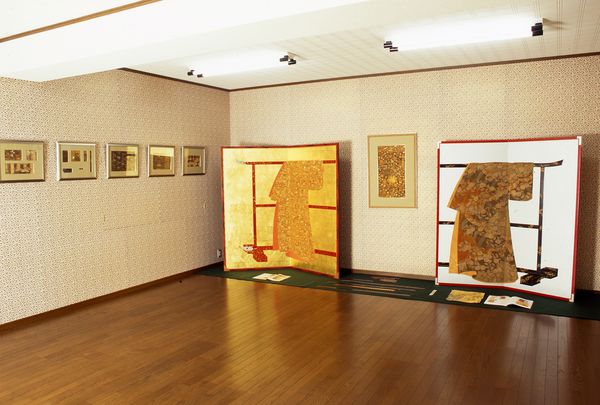鈴木時代裂研究所 鈴木 一 染織コレクションルーム / Hajime Suzuki Textile collection | ||
■所在地■ 京都市中京区丸太町通室町西入道場町4(鈴木時代裂研究所4階) 4,Dojyo-cho,Nakagyo-ku,Kyoto City,Kyoto,6040001 → アクセスマップ
■公開時間■ 午前十時~午後五時 (要予約、有料です) お問い合わせ TEL 075-231-2496 もしくは お問合せ まで
| ||
『展示にあたって』 鈴木 一 | ||
父・繁太郎が現・東京芸大(大正6年3月卒 図案第一部・号 東陽)に在学中、黒木欽堂先生(香川工芸学校長)の書生をしておりました。その折に、岡田三郎助先生の指導を受けながら、その頃から名物裂や古渡更紗に興味を持ち始めたようです。 卒業後白木屋(現東急)へ入社し、現東京国立博物館に通い古渡更紗(こわたりさらさ)の模写をし、それまでの父の蒐集品と合わせて「古渡印度更紗模様」(巧芸社・大正11年刊)に当時としては珍しいカラー印刷にて白木屋から出版されました。序文は森林太郎(鴎外)・今泉雄作両先生です。 終戦直後、父の急死により、私が蒐集研究を引き継ぎ、65年後に「名物更紗類聚」(光村推古書院・昭和60年刊)を出版する事になろうとは思ってもいませんでした。この本は少しでも現物に近く存在感のある印刷をとダイレクト印刷によって世に出すことができました。 名物裂の研究もこつこつと手探りながらまとめてきました。これも平成2年に「角川茶道大事典」の別冊「資料・索引編」の「名物裂総覧:図版集成・名譜要録」を担当し、一応まとめることができました。父の夢を少し果たすことができたと思っています。 織物のことも、染め物のことも、何の関係もない仕事の合間に文献を探し、資料を求め、時間を重ねてきました。 時を経た寸片の裂に魅せられて半世紀に余る人生を過ごしてきました。蒐めた裂は 私有に甘んずるものではないと思っています。 これからは、この方寸の裂の魅力や楽しさを知って頂く為や、古文献資料による 調査への協力、門戸を開き後進の染織に 関心のある人の輪を広げたいと思って います。物を見る眼を養うためには、先ず本物を見ることが肝要です。裂の場合は織り方も、 染め方も、作った人の名も、時代も教えてくれません。その裂を見分ける眼を養う お手伝いをするためのコレクションルームを作り、四季に分けて展示することにしま した。 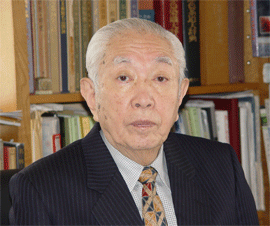 About the Exhibition Hajime SuzukiWhen my father was a student at what is now known as the Tokyo University of the Arts (March 1917) rooming as a student in accommodation provided by Kindo Kuroki (formerly the President of the Kagawa Arts and Crafts Academy) and under the pupelage of Saburosuke Okada, he began his lifelong passion and interest in meibutsu gire (auspicious fabric designs) and kowatari sarasa (dyed cotton designs that first arrived in Japan at the start of the 17th century). | ||
古渡更紗展 (3/1~5/30) Kowatari sarasa | ||
17世紀初頭から日本に渡来した木綿の生地に染められた布です。大名や茶の湯の数寄者に好まれ大切に遺された「更紗」を展示。ヒンズー語sarasa、ジャワ語sarasa、マレー語sararah,、ポルトガル語saraca、スペイン語zaraza、インドの地名suratが語源でしょうか? Kowatari sarasa refers to dyed cotton designed that was imported in Japan in early 17th century. This exhibition focuses on KOWATARI SARASA which were beloved by Daimyo , Japanese feudal lord and the masters of tea ceremony who had exquisite taste at that time. The name of SARASA was rerived moniker from several sources. In Hindi and JAVANESE, SARASA. In Malay, SARARAH In Portuguese SARACA and ZARAZA in Spanish. The speculation of Etymology of the term is linked to the Indian region, SURAT. | 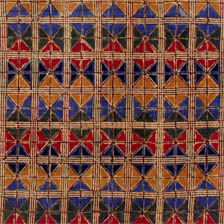 | |
竹屋町展 (6/1~8/30) TAKEYAMACHI | ||
17世紀初頭に古田織部が中国人を招き竹屋町通りで作らせ、当初は織部紗と言 われましたが後に「竹屋町」となりました。 紗の生地に金箔と色糸を横糸に沿って縫います。織物ではなく刺繍です。京都の東西の道です。
Daimyo FURUTA ORIBE invited Chinese craftsman to Kyoto and he made an effort to develop the skill of weaving at the district called Takeyamachi in early 16th century. Therefore, it was named TAKEYAMACHI SHA. SHA is the gauze or semi transparent fabric which were embroidered with the gold thread vertical and dyed weft horizontal TAKEYAMACHi is still Kyoto’s East West thoroughfares.
| 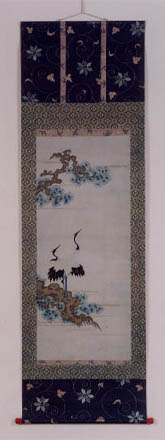 | |
| 名物裂展 (9/1~11/29) MEIBUTSU-GIRE | ||
茶の湯で特に大切にされた茶器、茶碗等を入れる袋に名物裂と言われる布が使用されています。 金襴、純子、間道、雑載と区分されています。 中国で織られた染織品です。 茶入れの袋が現在の価格で800萬円ほどです。 The master of tea ceremony prized tea utensils, tea bowls, etc and stored in the pouches made of rare fabric. Those fabrics are categorized, gold brocade, donsu(kind of rinzu silk) kando(striped design) and zassai( repeated pattern). The weaving fabric designed based on Chinese authentic patterns. At that time, the price of the tea container pouch of the fabric weaved in China, fetch up to current value of 8 million yen. | 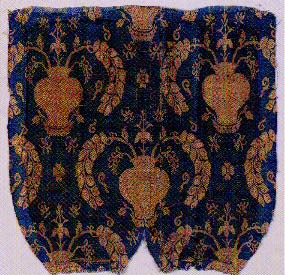 | |
| 珍しい裂展 (12/1~2/27) Rare Dyeing and Weaving | ||
染め、織り、刺繍、絞りなどで珍しい布を集めてみました。 皆様と一緒に試行錯誤してみたいと思っています。 「ウーン」と唸ってもらえそうな染織品です。
This exhibition is the collection of the fabric of rare design、 featured in dyeing , weaving ,embroidery and shibori(tie-dyeing) I am looking forward to meet you and discuss about the rare fabrics at the exhibition. I And I hope those rare fabrics will give you sigh and admiration and WONDER.
| 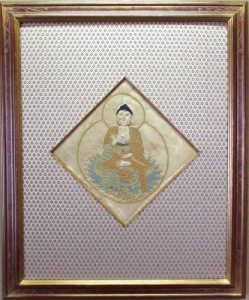 | |
